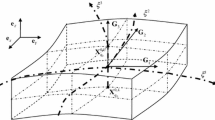Abstract.
This paper describes a set of procedures by which an analyst can idealise slender 2D shell structures for linear static analysis using reduced-dimensional beam finite elements. The first step is the development of the topological operations that are necessary to achieve the desired dimensionally reduced representation. Next, the automatic derivation of necessary geometric and physical properties of the reduced dimensional entities are described, together with the application of appropriate coupling constraints between dimensions. Dimensional reduction of shell models involves finding areas of the geometric model whose dimensions are such that this region may be represented in an analysis model with a 1D beam. Using the medial axis transform, geometric measures are defined for identifying such areas in the geometric model. However, topological features of the model and its medial axis were also identified as significant in the automation of dimensional reduction. The application of the medial axis transform to automatic dimensional reduction is described and example models given.
Similar content being viewed by others
Author information
Authors and Affiliations
Rights and permissions
About this article
Cite this article
Donaghy, R., Armstrong, C. & Price, M. Dimensional Reduction of Surface Models for Analysis. EWC 16, 24–35 (2000). https://doi.org/10.1007/s003660050034
Issue Date:
DOI: https://doi.org/10.1007/s003660050034




